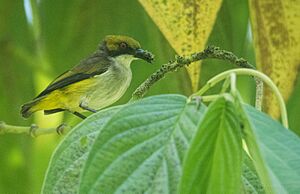Olive-capped flowerpecker facts for kids
Quick facts for kids Olive-capped flowerpecker |
|
|---|---|
 |
|
| Nominate subspecies seen in South Cotobato. | |
| Conservation status | |
| Scientific classification | |
| Genus: |
Dicaeum
|
| Species: |
nigrilore
|
The olive-capped flowerpecker (Dicaeum nigrilore) is a small, colorful bird. It belongs to the Dicaeidae family, also known as flowerpeckers. This special bird lives only on the island of Mindanao in the Philippines. Its natural habitat is the cool, moist montane forests found high up in the mountains.
Contents
Meet the Olive-Capped Flowerpecker
This bird is quite small and has a bill that is rather long. Its back is a pretty olive-green color. The edges of its wings are a bit darker. Its head shines with a golden-olive shade.
What Does It Look Like?
The olive-capped flowerpecker has a pale gray throat. A thin black line separates its throat from its golden-olive head. Its chest is also pale gray. The sides of its body and the area under its tail are pale yellow. You can easily spot its black legs and bright red eye.
How Does It Sound?
This bird has a unique voice. It makes a high-pitched whistle that goes up in sound. It also has a rough "jiik!" call. You might often see it eating from trees that have fruits or flowers.
Types of Olive-Capped Flowerpeckers
Scientists recognize two main types, or subspecies, of the olive-capped flowerpecker. These types have slight differences in their looks and where they live.
- Dicaeum nigrilore nigrilore: This type is found in the western, central, and southern parts of Mindanao. It has a more noticeable yellow patch on its lower back, called a rump.
- Dicaeum nigrilore diuatae: This type lives in the northeastern part of Mindanao. It generally has a darker green color and looks a bit duller. Its rump is a greenish-yellow.
There might be a third type of this bird. It has a yellowish-green head and is found in Southeast Mindanao. More studies are needed to confirm if this is a new subspecies.
Where It Lives and Its Safety
The olive-capped flowerpecker makes its home in tropical moist forests. These forests are found high up in the mountains, usually above 900 meters (about 3,000 feet) above sea level.
Conservation Status
The International Union for Conservation of Nature (IUCN) has listed this bird as a least-concern species. This means that even though it lives in a specific area, there are still many of them. It is quite common in the places where it lives.
Protecting Its Home
A big part of its mountain home is still safe. This is because the mountains are rugged and hard to reach. However, the bird's habitat is still at risk from certain activities. These include cutting down forests, mining, and changing land for other uses. Sometimes, people also clear land by burning it, which is called slash-and-burn. These activities affect the bird's home, but not as much as they do for birds living in lowland forests.


